Digital Image Correlation (DIC) Analysis of the 3 December 2013 Montescaglioso Landslide (Basilicata, Southern Italy): Results from a Multi-Dataset Investigation
Abstract
:1. Introduction
2. Basic Principles of Digital Image Correlation (DIC)
3. 3 December 2013 Montescaglioso Landslide
4. Materials and Methods
4.1. Available Datasets
- -
- COSMO-SkyMed SAR Images (in both ascending and descending geometry);
- -
- LANDSAT 8 OLI-TIRS Images;
- -
- DTM; and,
- -
- High-resolution Aerial Optical Images.
4.2. Image Processing Tools
- -
- ENVI® v. 5.4 (Environment for Visualizing Images) [58]: ENVI® was used to visualize the available dataset and perform oversampling of both aerial orthophotos to 0.8 m/pixel geometric resolution (by using the nearest-neighbor interpolation method);
- -
- ESRI ArcGIS [59]: This software performs a number of surface operations and generates eight shaded reliefs before performing the DIC analysis on the pre-post DTM pair; and,
- -
- SARPROZ© (SAR PROcessing tool by periZ) [60]: This tool was used to perform time-averaged filtering on the entire CSK SAR amplitude dataset (in both ascending and descending geometries).
- -
- COSI-Corr (Co-registration of Optically Sensed Images and Correlation) [61] is a sub-pixel image correlation algorithm (developed by the authors of [62,63] that is available as an open-source plug-in for the ENVI® software package. According to References [33,54,62,64,65], to allow for displacement measurements, an initial parameter setting has to be chosen as follows: (i) a window size, which is the size in pixels of the patches that will be correlated in the x and y directions; (ii) a step, which determines the step in the x and y directions in pixels between two sliding windows; and (iii), the type of correlator engine to be chosen, between frequency (Fourier based) and statistical typology. Further detailed descriptions of the algorithms and characteristics of this software are available in References [62,66].
- -
- GOM Correlate [67] is a DIC evaluation software program used for materials research and component testing. GOM Correlate software is based on a parametric concept that forms the underlying foundation for every single function [68,69]. This parametric approach ensures that all process steps are traceable, thereby guaranteeing process reliability for measuring results. In addition, in GOM Correlate, parameters must be initialized. While establishing the surface component, the software finds square-shaped facets in the collected scenes. Basically, the square facets, set in GOM Correlate, are equivalent to the subset, set in COSI-Corr analyses. GOM Correlate software identifies these facets by the stochastic pattern quality structure. The distance between the individual square shapes has to then be properly set. The point distance describes the distance between the center points of the adjacent square facets. This setting influences the measurement point density within the surface component. The measurement point density increases as the point distance decreases. A higher spatial resolution is obtained by decreasing the distance between the facets [68,69].
5. Data Analyses and Results
5.1. Image Pre-Processing
5.2. DIC Analyses
5.2.1. Analyses of the Background Noise
5.2.2. Analyses of the Temporal Resolution Effect
5.2.3. Analyses of the Landslide Deformation
6. Discussion
7. Conclusions
Author Contributions
Funding
Acknowledgments
Conflicts of Interest
References
- Alexander, E.D. Vulnerability to landslides. In Landslide Hazard and Risk; Glade, T., Anderson, M.G., Crozier, M.J., Eds.; John Wiley & Sons, Ltd.: New York, NY, USA, 2004; pp. 175–198. [Google Scholar]
- Kjekstad, O.; Highland, L.M. Economic and social impacts of landslides. In Landslides—Disaster Risk Reduction; Sassa, D., Canuti, P., Eds.; Springer: Berlin, Germany, 2008; pp. 573–587. [Google Scholar]
- Sanchez, C.; Lee, T.-S.; Young, S.; Batts, D.; Benjamin, J.; Malilay, J. Risk factors for mortality during the 2002 landslides in Chuuk, Federated States of Micronesia. Disasters 2009, 33, 705–720. [Google Scholar] [CrossRef] [PubMed]
- Petley, D. Global patterns of loss of life from landslides. Geology 2012, 40, 927–930. [Google Scholar] [CrossRef]
- Baroň, I.; Supper, R. Application and reliability of techniques for landslide site investigation, monitoring and early warning—Outcomes from a questionnaire study. Nat. Hazards Earth Syst. Sci. 2013, 13, 3157–3168. [Google Scholar] [CrossRef]
- Mantovani, F.; Soeters, R.; Van Wasten, C.J. Remote sensing techniques for landslide studies and hazard zonation in Europe. Geomorphology 1996, 15, 213–225. [Google Scholar] [CrossRef]
- Delacourt, C.; Allemand, P.; Casson, B.; Vadon, H. Velocity field of the “La Clapiere” landslide measured by the correlation of aerial and QuickBird satellite images. Geophys. Res. Lett. 2004, 31, L15619. [Google Scholar] [CrossRef]
- Delacourt, C.; Allemand, P.; Berthier, E.; Raucoules, D.; Casson, B.; Grandjean, P.; Pambrun, C.; Varel, E. Remote-sensing techniques for analysing landslide kinematics: A review. Bull. Soc. Géol. Fr. 2007, 178, 89–100. [Google Scholar] [CrossRef]
- Voigt, S.; Kemper, T.; Riedlinger, T.; Kiefl, R.; Scholte, K.; Mehl, H. Satellite Image Analysis for Disaster and Crisis-Management Support. IEEE Trans. Geosci. Remote Sens. 2007, 45. [Google Scholar] [CrossRef]
- Mazzanti, P. Displacement monitoring by Terrestrial SAR Interferometry for geotechnical purposes. NHAZCA S. r. l., Geotechnical Instrumentation News, June 2011; 25–28. [Google Scholar]
- Mazzanti, P. Remote monitoring of deformation. An overview of the seven methods described in previous GINs. Geotechnical Instrumentation News, December 2012; 24–29. [Google Scholar]
- Mazzanti, P.; Pezzetti, G. Traditional and Innovative Techniques for Landslide Monitoring: Dissertation on Designed Criteria. In Proceedings of the 19th Tagung für Ingenieurgeologie mit Forum für junge Ingenieurgeologen, Technische Universität München, Germany, 13–16 March 2013. [Google Scholar]
- Qiao, G.; Lu, P.; Scaioni, M.; Xu, S.; Tong, X.; Feng, T.; Wu, H.; Chen, W.; Tian, Y.; Wang, W.; et al. Landslide Investigation with Remote Sensing and Sensor Network: From Susceptibility Mapping and Scaled-down Simulation towards in situ Sensor Network Design. Remote Sens. 2013, 5, 4319–4346. [Google Scholar] [CrossRef] [Green Version]
- Scaioni, M.; Longoni, L.; Melillo, V.; Papini, M. Remote sensing for landslide investigations: An overview of recent achievements and perspectives. Remote Sens. 2014, 6, 9600–9652. [Google Scholar] [CrossRef]
- Ciampalini, A.; Raspini, F.; Bianchini, S.; Frodella, W.; Bardi, F.; Lagomarsino, D.; Di Traglia, F.; Moretti, S.; Prioietti, C.; Pagliara, P.; et al. Remote sensing as tool for development of landslide databases: The case of the Messina Province (Italy). Geomorphology 2015, 249, 103–118. [Google Scholar] [CrossRef]
- Mazzanti, P.; De Blasio, F.V.; Di Bastiano, C.; Bozzano, F. Inferring the high velocity of landslides in Valles Marineris on Mars from morphological analysis. Earth Planets Space 2016, 68. [Google Scholar] [CrossRef]
- Williams, J.; Rosser, N.J.; Kincey, M.E.; Benjamin, J.; Oven, K.J.; Densmore, A.L.; Milledge, D.G.; Robinson, T.R.; Jordan, C.A.; Dijkstra, T.A. Satellite-based emergency mapping using optical imagery: Experience and reflections from the 2015 Nepal earthquakes. Nat. Hazards Earth Syst. Sci. 2018, 18, 185–205. [Google Scholar] [CrossRef]
- Dewitte, O.; Jasselette, J.C.; Cornet, Y.; Van Den Eeckhaut, M.; Collignon, A.; Poesen, J.; Demoulin, A. Tracking landslide displacements by multi-temporal DTMs: A combined aerial stereophotogrammetric and LIDAR approach in western Belgium. Eng. Geol. 2008, 99, 11–22. [Google Scholar] [CrossRef]
- Cascini, L.; Fornaro, G.; Peduto, D. Advanced low- and full-resolution DInSAR map generation for slow-moving landslide analysis at different scales. Eng. Geol. 2010, 112, 29–42. [Google Scholar] [CrossRef]
- Handwerger, A.L.; Roering, J.J.; Schmidt, D.A.; Rempel, A.W. Kinematics of earthflows in the Northern California Coast Ranges using satellite interferometry. Geomorphology 2015, 246, 321–333. [Google Scholar] [CrossRef]
- Mazzanti, P.; Bozzano, F.; Cipriani, I.; Prestininzi, A. New insights into the temporal prediction of landslides by a terrestrial SAR interferometry monitoring case study. Landslides 2015, 12, 55. [Google Scholar] [CrossRef]
- Moretto, S.; Bozzano, F.; Esposito, C.; Mazzanti, P.; Rocca, A. Assessment of Landslide Pre-Failure Monitoring and Forecasting Using Satellite SAR Interferometry. Geosciences 2017, 7, 36. [Google Scholar] [CrossRef]
- Bozzano, F.; Caporossi, P.; Esposito, C.; Martino, S.; Mazzanti, P.; Moretto, S.; Scarascia Mugnozza, G.; Rizzo, A.M. Mechanism of the Montescaglioso landslide (Southern Italy) inferred by geological survey and remote sensing. In Advancing Culture of Living with Landslides; Sassa, K., Mikoş, M., Yin, Y., Eds.; Springer International Publishing AG: Basel, Switzerland, 2017. [Google Scholar]
- White, D.J.; Take, W.A.; Bolton, M.D. Soil deformation measurement using particle image velocimetry (PIV) and photogrammetry. Geotechnique 2003, 53, 619–631. [Google Scholar] [CrossRef]
- Le Corvec, N.; Walter, T.R. Volcano spreading and fault interaction influenced by rift zone intrusions: Insights from analogue experiments analyzed with digital image correlation technique. J. Volcanol. Geotherm. Res. 2009, 183, 170–182. [Google Scholar] [CrossRef]
- Kääb, A. Monitoring high-mountain terrain deformation from repeated air- and spaceborne optical data: Examples using digital aerial imagery and ASTER data. ISPRS J. Photogramm. Remote Sens. 2002, 57, 39–52. [Google Scholar] [CrossRef]
- Kääb, A.; Huggel, C.; Fischer, L.; Gue, S.; Paul, F.; Roer, I.; Salzmann, N. Remote sensing of glacier and permafrost-related hazards in high mountains: An overview. Nat. Hazards Earth Syst. Sci. 2005, 5, 527–554. [Google Scholar]
- Ruiz, L.; Berthier, E.; Masiokas, M.; Pitte, P.; Villalba, R. First surface velocity maps for glaciers of Monte Tronador, North Patagonian Andes, derived from sequential Pléiades satellite images. J. Glaciol. 2015, 61. [Google Scholar] [CrossRef]
- Van Puymbroeck, N.; Michel, R.; Binet, R.; Avouac, J.P.; Taboury, J. Measuring earthquakes from optical satellite images. Appl. Opt. 2000, 39, 3486–3494. [Google Scholar] [CrossRef] [PubMed]
- Avouac, J.P.; Ayoub, F.; Wei, S.; Ampuero, J.P.; Meng, L.; Leprince, S.; Jolivet, R.; Duputel, Z.; Helmberger, D. The 2013, Mw 7.7 Balochistan earthquake, energetic strike-slip reactivation of a thrust fault. Earth Planet. Sci. Lett. 2014, 391, 128–134. [Google Scholar] [CrossRef] [Green Version]
- Travelletti, J.; Delacourt, C.; Allemand, P.; Malet, J.P.; Schmittbhul, J.; Toussaint, R.; Bastard, M. Correlation of multi-temporal ground-based optical images for landslide monitoring: Application, potential and limitations. ISPRS J. Photogramm. Remote Sens. 2012, 70, 39–55. [Google Scholar] [CrossRef]
- Travelletti, J.; Malet, J.P.; Delacourt, C. Image-based correlation of Laser Scanning point cloud time series for landslide monitoring. Int. J. Appl. Earth Obs. Geoinf. 2014, 32, 1–18. [Google Scholar] [CrossRef]
- Lucieer, A.; De Jong, S.M.; Turner, D. Mapping landslide displacements using Structure from Motion (SfM) and image correlation of multi-temporal UAV photography. Prog. Phys. Geogr. 2014, 38, 97–116. [Google Scholar] [CrossRef]
- Bickel, V.T.; Manconi, A.; Amann, F. Quantitative Assessment of Digital Image Correlation Methods to Detect and Monitor Surface Displacements of Large Slope Instabilities. Remote Sens. 2018, 10, 865. [Google Scholar] [CrossRef]
- Stumpf, A. Landslide Recognition and Monitoring with Remotely Sensed Data from Passive Optical Sensors. Ph.D. Thesis, University of Strasbourg, Strasbourg, France, 18 December 2013. [Google Scholar]
- Raucoules, D.; Ristori, B.; De Michele, M.; Briole, P. Surface displacement of the Mw 7 Machaze earthquake (Mozambique): Complementary use of multiband InSAR and radar amplitude image correlation with elastic modelling. Remote Sens. Environ. 2011, 114, 2211–2218. [Google Scholar] [CrossRef] [Green Version]
- Singleton, A.; Li, Z.; Hoey, T.; Muller, J.P. Evaluating sub-pixel offset techniques as an alternative to D-InSAR for monitoring episodic landslide movements in vegetated terrain. Remote Sens. Environ. 2014, 147, 133–144. [Google Scholar] [CrossRef]
- Manconi, A.; Casu, F.; Ardizzone, F.; Bonano, M.; Cardinali, M.; De Luca, C.; Gueguen, E.; Marchesini, I.; Parise, M.; Vennari, C.; et al. Brief Communication: Rapid mapping of landslide events: The 3 December 2013 Montescaglioso landslide, Italy. Nat. Hazards Earth Syst. Sci. 2014, 14, 1835–1841. [Google Scholar] [CrossRef] [Green Version]
- Raspini, F.; Ciampalini, A.; Del Conte, S.; Lombardi, L.; Nocentini, M.; Gigli, G.; Ferretti, A.; Casagli, N. Exploitation of Amplitude and Phase of Satellite SAR Images for Landslide Mapping: The Case of Montescaglioso (South Italy). Remote Sens. 2015, 7, 14576–14596. [Google Scholar] [CrossRef] [Green Version]
- Bozzano, F.; Mazzanti, P.; Perissin, D.; Rocca, A.; De Pari, P.; Discienza, M.E. Basin Scale Assessment of Landslides Geomorphological Setting by Advanced InSAR Analysis. Remote Sens. 2017, 9, 267. [Google Scholar] [CrossRef]
- Amanti, M.; Chiessi, V.; Guarino, P.M.; Spizzichino, D.; Troccoli, A.; Vizzini, G. Relazione finale di cui all’art. 5 (b) della Convenzione Operativa tra il Commissario Delegato, O.C.D.P.C. n. 151 del 21.2.2014 e l’Istituto Superiore per la Protezione e la Ricerca Ambientale (ISPRA) per monitoraggio e studi sulla frana di Montescaglioso (MT) del 3 dicembre 2013, ISPRA—Istituto Superiore per la Protezione e la Ricerca Ambientale: Rome, Italy, 2014. (In Italian)
- Carlà, T.; Raspini, F.; Intrieri, E.; Casagli, N. A simple method to help determine landslide susceptibility from spaceborne InSAR data: The Montescaglioso case study. Environ Earth Sci. 2016, 75, 1492. [Google Scholar] [CrossRef]
- Pellicani, R.; Spilotro, G.; Ermini, R.; Sdao, F. The large Montescaglioso landslide of December 2013 after prolonged and severe seasonal climate conditions. In Proceedings of the n. 186 of 12th International Symposium of Landslides, Naples, Italy, 12–19 June 2016. [Google Scholar]
- Ekstrom, M.P. Digital Image Processing Techniques; Academic Press, Inc.: London, UK, 1984. [Google Scholar]
- Pan, B.; Xie, H.; Wang, Z.; Qian, K.; Wang, Z. Study on Subset Size Selection in Digital Image Correlation for Speckle Patterns; No. 10/OPTICS EXPRESS 7037; Optical Society of America: Washington, DC, USA, 2008; Volume 16. [Google Scholar]
- Mazzanti, P. Toward transportation asset management: What is the role of geotechnical monitoring? J. Civ. Struct. Health Monit. 2017. [Google Scholar] [CrossRef]
- Sutton, M.A.; Orteu, J.J.; Schreier, H.W. Shape, Motion and Deformation Measurements: Basic Concepts, Theory and Applications; Springer Science: Berlin, Germany, 2009; Chapter V. [Google Scholar]
- Lecompte, D.; Smits, A.; Bossuyt, S.; Sol, H.; Vantomme, J.; Van Hemelrijck, D.; Habraken, A.M. Quality assessment of speckle patterns for digital image correlation. Opt. Lasers Eng. 2006, 44, 1132–1145. [Google Scholar] [CrossRef] [Green Version]
- Lava, P.; Cooreman, S.; Coppieters, S.; De Strycker, M.; Debruyne, D. Assessment of measuring errors in DIC using deformation fields generated by plastic FEA. Opt. Lasers Eng. 2009, 47, 747–753. [Google Scholar] [CrossRef]
- Lava, P.; Cooreman, S.; Debruyne, D. Study of systematic errors in strain fields obtained via DIC using heterogeneous deformation generated by plastic FEA. Opt. Lasers Eng. 2010, 48, 457–468. [Google Scholar] [CrossRef]
- Lava, P.; Coppieters, S.; Wang, Y.; Van Houtte, P.; Debruyne, D. Error estimation in measuring strain fields with DIC on planar sheet metal specimens with a non-perpendicular camera alignment. Opt. Lasers Eng. 2010, 49, 57–65. [Google Scholar] [CrossRef]
- MatchID Manual. Documentation. MatchID Metrology beyond colors. Ghent, Belgium. Available online: http://matchid.eu/Documentation/ (accessed on 06 September 2018).
- Yoneyama, S.; Murasawa, G. Digital image correlation. In Experimental Mechanics; Freire, J.F., Ed.; Encyclopedia of Life Support System (EOLSS) Publishers: Oxford, UK, 2009. [Google Scholar]
- Leprince, S. Monitoring Earth Surface Dynamics with Optical Imagery. Ph.D. Thesis, California Institute of Technology, Pasadena, CA, USA, 16 May 2008. [Google Scholar]
- Pascale, S.; Pastore, V.; Sdao, F.; Sole, A.; Roubis, D.; Lorenzo, P. Use of Remote Sensing Data to Landslide Change Detection: Montescaglioso Large Landslide (Basilicata, Southern Italy). Int. J. Agric. Environ. Inf. Syst. 2012, 3, 14–25. [Google Scholar] [CrossRef]
- Cruden, D.M.; Varnes, D.J. Landslide types and processes. In Landslides: Investigation and Mitigation; Turner, A.K., Schuster, R.L., Eds.; National Academy Press: Washington, DC, USA, 1996; pp. 36–75. [Google Scholar]
- Nagler, T.; Mayer, C.; Rott, H. Feasibility of DInsar for mapping complex motion fields of Alpine ice and rock glaciers. In Proceedings of the 3rd International Symposium on Retrieval of Bio- and Geophysical Parameters from SAR Data for Land Applications, Sheffield, UK, 11–14 September 2002; pp. 377–382. [Google Scholar]
- ENVI® v. 5.4. ENvironment for Visualizing Images. Harris® Geospatial Solutions, Inc.: Boulder, CO, USA. Available online: http://www.harrisgeospatial.com/SoftwareTechnology/ENVI.aspx (accessed on 6 September 2018).
- ArcGIS. Environmental Systems Research Institute (ESRI): Redlands, CA, USA. Available online: http://www.esri.com/arcgis/about-arcgis. (accessed on 6 September 2018).
- SARPROZ©. SAR PROcessing Tool by periZ. Available online: https://www.sarproz.com/ (accessed on 6 September 2018).
- COSI-Corr. California Institute of Technology (CALTECH), Tectonics Observatory (TO): Pasadena, CA, USA. Available online: http://www.tectonics.caltech.edu/slip_history/spot_coseis/index.html (accessed on 6 September 2018).
- Leprince, S.; Barbot, S.; Ayoub, F.; Ayouac, J.P. Automatic and precise orthorectification, co-registration, and sub-pixel correlation of satellite images, application to ground deformation measurements. IEEE Trans. Geosci. Remote Sens. 2007, 45, 1529–1558. [Google Scholar] [CrossRef]
- Ayoub, F.; Leprince, S.; Avouac, J.P. Co-registration and Correlation of Aerial Photographs for Ground Deformation Measurements. ISPRS J. Photogramm. Remote Sens. 2009, 64, 551–560. [Google Scholar] [CrossRef]
- Leprince, S.; Berthier, E.; Ayoub, F.; Delacourt, C.; Avouac, J.P. Monitoring earth surface dynamics with optical imagery. EOS Trans. Am. Geophys. Union 2008, 89. [Google Scholar] [CrossRef]
- Leprince, S.; Musé, P.; Avouac, J.P. In-Flight CCD Distortion Calibration for Pushbroom Satellites Based on Subpixel Correlation. IEEE Trans. Geosci. Remote Sens. 2008, 46, 2675–2683. [Google Scholar] [CrossRef] [Green Version]
- Ayoub, F.; Leprince, S.; Avouac, J.P. User’s Guide to COSI-Corr: Co-Registration of Optically Sensed Images and Correlation; California Institute of Technology: Pasadena, CA, USA, 2017. [Google Scholar]
- GOM Correlate. GOM—Precise Industrial 3D Metrology. Braunschweig, Germany. Available online: https://www.gom.com/index.html (accessed on 6 September 2018).
- GOM GmbH. GOM Correlate Professional V8 SR1 Manual Basic. Inspection—3D Testing; GOM mbH: Braunschweig, Germany, 2015; pp. 7–8. [Google Scholar]
- GOM GmbH. GOM Testing—Technical Documentation as of V8 SR1, Digital Image Correlation and Strain Computation Basics; GOM mbH: Braunschweig, Germany, 2016. [Google Scholar]
- MATLAB® v. R2017b. The MathWorks, Inc.: Natick, MA, USA. Available online: https://it.mathworks.com/ (accessed on 6 September 2018).
- Turner, D.; Lucieer, A.; De Jong, S.M. Time Series Analysis of Landslide Dynamics Using an Unmanned Aerial Vehicle (UAV). Remote Sens. 2015, 7, 1736–1757. [Google Scholar] [CrossRef] [Green Version]
- Earth Resources Observation and Science (EROS) Center, USGS. Landsat 8 OLI (Operational Land Imager) and TIRS (Thermal Infrared Sensor). Sioux Falls, SD, USA. Available online: https://lta.cr.usgs.gov/L8 (accessed on 6 September 2018).
- Elefante, S.; Manconi, A.; Bonano, M.; De Luca, C.; Casu, F. Three-dimensional ground displacement retrieved from SAR data in a landslide emergency scenario. In Proceedings of the 2014 IEEE International Geoscience and Remote Sensing Symposium (IGARSS), Quebec City, QC, Canada, 13–18 July 2014. [Google Scholar] [CrossRef]
- Spilotro, G.; Ermini, R.; Sdao, F.; Pellicani, R. Post failure behaviour of landslide bodies: The large Montescaglioso landslide of 2013 dec. In Proceedings of the 2015 EGU General Assembly 2015, Vienna, Austria, 12–17 April 2015; Volume 17. [Google Scholar]
- Amanti, M.; Chiessi, V.; Guarino, P.M.; Spizzichino, D.; Troccoli, A.; Vizzini, G.; Facio, N.L.; Lollino, P.; Parise, M.; Vennari, C. Back-analysis of a large earth-slide in stiff clays induced by intense rainfalls. In Landslides and Engineered Slopes: Experience, Theory and Practice, Proceedings of the 12th International Symposium on Landslides, Napoli, Italy, 12–19 June 2016; Aversa, S., Cascini, L., Picarelli, L., Scavia, C., Eds.; Associazione Geotecnica Italiana: Rome, Italy, 2016; ISBN 978-1-138-02988-0. [Google Scholar]
- Parise, M.; Gueguen, E.; Vennari, C. Mapping Surface Features Produced by an Active Landslide. In Proceedings of the World Multidisciplinary Earth Sciences Symposium (WMESS 2016), Prague, Czech Republic, 5–9 September 2016; IOP Conf. Series: Earth and Environmental Science. Volume 44, p. 022029. [Google Scholar] [CrossRef]
- Delacourt, C.; Raucoules, D.; Le Mouélic, S.; Carnec, C.; Feurer, D.; Allemand, P.; Cruchet, M. Observation of a Large Landslide on La Reunion Island Using Differential Sar Interferometry (JERS and Radarsat) and Correlation of Optical (Spot5 and Aerial) Images. Sensors 2009, 9, 616–630. [Google Scholar] [CrossRef] [PubMed] [Green Version]
- Debella-Gilo, M.; Kääb, A. Sub-pixel precision image matching for measuring surface displacements on mass movements using normalized cross-correlation. Remote Sens. Environ. 2011, 115, 130–142. [Google Scholar] [CrossRef] [Green Version]
- Stumpf, A.; Malet, J.P.; Allemand, P.; Ulrich, P. Surface reconstruction and landslide displacement measurements with Pléiades satellite images. ISPRS J. Photogramm. Remote Sens. 2014, 95. [Google Scholar] [CrossRef]
- Rosu, A.M.; Pierrot-Deseilligny, M.; Delorme, A.; Binet, R.; Klinger, Y. Measurement of ground displacement from optical satellite image correlation using the free open-source software MicMac. ISPRS J. Photogramm. Remote Sens. 2015, 100, 48–59. [Google Scholar] [CrossRef]
- Kropáček, J.; Vařilová, Z.; Baroň, I.; Bhattacharya, A.; Eberle, J.; Hochschild, V. Remote Sensing for Characterisation and Kinematic Analysis of Large Slope Failures: Debre Sina Landslide, Main Ethiopian Rift Escarpment. Remote Sens. 2015, 7, 16183–16203. [Google Scholar] [CrossRef] [Green Version]
- Shi, B.; Liu, C.; Wu, H.; Lu, P. Elementary Analysis of the Mechanism of Xishan Landslide Based on Pixel Tracking on VHR Images. IJGE 2016, 2, 53–71. [Google Scholar] [CrossRef]
- Stumpf, A.; Michéa, D.; Malet, J.P. Improved Co-Registration of Sentinel-2 and Landsat-8 Imagery for Earth Surface Motion Measurements. Remote Sens. 2018, 10, 160. [Google Scholar] [CrossRef]
- Moragues, S.; Lenzano, M.G.; Lo Vecchio, A.; Falaschi, D.; Lenzano, L. Surface velocities of Upsala glacier, Southern Patagonian Andes, estimated using cross-correlation satellite imagery: 2013-2014 period. Andean Geol. 2018, 45, 87–103. [Google Scholar] [CrossRef]
- Redpath, T.A.N.; Sirguey, P.; Fitzsimons, S.J.; Kääb, A. Accuracy assessment for mapping glacier flow velocity and detecting flow dynamics from ASTER satellite imagery: Tasman Glacier, New Zealand. Remote Sens. Environ. 2013, 133, 90–101. [Google Scholar] [CrossRef]
- Oliver, C.J. Information from SAR images. J. Phys. D Appl. Phys. 1991, 24, 1493. [Google Scholar] [CrossRef]
- Bratsolis, E.; Bampasidis, G.; Solomonidou, A.; Coustenis, A. A despeckle filter for the Cassini synthetic aperture radar images of Titan’s surface. Planet. Space Sci. 2012, 61, 108–113. [Google Scholar] [CrossRef]
- Masoomi, A.; Hamzehyan, R.; Shirazi, N.C. Speckle Reduction Approach for SAR Image in Satellite Communication. Int. J. Mach. Learn. Comput. 2012, 2, 62. [Google Scholar] [CrossRef]
- Kooshesh, M.; Akbarizadeh, G. Despeckling algorithm for remote sensing synthetic aperture radar images using multi-scale curvelet transform. In Proceedings of the International Symposium on Artificial Intelligence and Signal Processing (AISP), Tehran, Iran, 3–5 March 2015. [Google Scholar] [CrossRef]
- Mangalraj, P.; Agrawal, A. Despeckling of SAR images by directional representation and directional restoration. Opt. Int. J. Light Electron Opt. 2016, 127, 116–121. [Google Scholar] [CrossRef]
- Kross, A.; Fernandes, R.; Seaquist, J.; Beaubien, E. The effect of the temporal resolution of NDVI data on season onset dates and trends across Canadian broadleaf forests. Remote Sens. Environ. 2011, 115, 1564–1575. [Google Scholar] [CrossRef]
- Delacourt, C.; Allemand, P.; Squarzoni, C.; Picard, F.; Raucolules, D.; Carnec, C. Potential and limitation of ERS-Differential SAR Interferometry for landslide studies in the French Alps and Pyrenees. In Proceedings of the FRINGE 2003 Workshop (ESA SP-550), Rome, Italy, 1–5 December 2003. [Google Scholar]
- Schirer, G. SAR Geocoding: Data and Systems; Wichmann: Karlsruhe, Germany, 1993; 435p. [Google Scholar]
- Kavetski, D.; Fenicia, F.; Clark, M.C. Impact of temporal data resolution on parameter inference and model identification in conceptual hydrological modeling: Insights from an experimental catchment. Water Resour. Res. 2011, 47. [Google Scholar] [CrossRef] [Green Version]
- Zebker, H.A.; Villasenor, J. Decorrelation in interferometric radar echoes. IEEE Trans. Geosci. Remote Sens. 1992, 30, 950–959. [Google Scholar] [CrossRef] [Green Version]
- Michel, R.; Avouac, J.P.; Taboury, J. Measuring ground displacements from SAR amplitude images: Application to the Landers earthquake. Geophys. Res. Lett. 1999, 26, 875–878. [Google Scholar] [CrossRef]
- Bamler, R.; Eineder, M. Accuracy of differential shift estimation by correlation and split-bandwidth interferometry for wideband and delta-k SAR systems. Geosci. Remote Sens. Lett. 2005, 2, 151–155. [Google Scholar] [CrossRef]
- Avouac, J.P.; Ayoub, F.; Leprince, S.; Konca, O.; Helmberger, D.V. The 2005, Mw 7.6 Kashmir earthquake: Sub-pixel correlation of ASTER images and seismic waveforms analysis. Earth Planet. Sci. Lett. 2006, 249, 514–528. [Google Scholar] [CrossRef]
- Fujiwara, S.; Tobita, M.; Sato, H.P.; Ozawa, S.; Une, H.; Koaarai, M.; Nakai, H.; Fujiwara, M.; Yarai, H.; Nishimura, T.; et al. Satellite data gives snapshot of the 2005 Pakistan earthquake. EOS Trans.-Am. Geophys. Union 2006, 87, 73–84. [Google Scholar] [CrossRef]
- Pathier, E.; Fielding, E.J.; Wright, T.J.; Walker, R.; Parsons, B.E.; Hensley, S. Displacement field and slip distribution of the 2005 Kashmir earthquake from SAR imagery. Geophys. Res. Lett. 2006, 33. [Google Scholar] [CrossRef]
- Yan, Y.; Trouvé, E.; Pinel, V.; Pathier, E.; Bisserier, A.; Mauris, G.; Galichet, S. Assimilation of D-InSAR and sub-pixel image correlation displacement measurements for coseismic fault parameter estimation. In Proceedings of the 2010 IEEE International Geoscience and Remote Sensing Symposium, Honolulu, HI, USA, 25–30 July 2010. [Google Scholar] [CrossRef]
- Yan, Y.; Pinel, V.; Trouvé, E.; Pathier, E.; Galichet, S.; Mauris, G.; Bisserier, A. Combination of differential interferometry and sub-pixel image correlation in measurement of the 2005 Kashmir Earthquake displacement field. In Proceedings of the ‘Fringe 2009 Workshop’, Rome, Italy, 30 November–4 December 2009. [Google Scholar]
- Schubert, A.; Faes, A.; Kääb, A.; Meier, E. Glacier surface velocity estimation using repeat TerraSAR-X images: Wavelet- vs. correlation-based image matching. ISPRS J. Photogramm. Remote Sens. 2013, 82, 49–62. [Google Scholar] [CrossRef]
- Zhao, C.; Lu, Z.; Zhang, Q. Time-series deformation monitoring over mining regions with SAR intensity-based offset measurements. Remote Sens. Lett. 2013, 4, 436–445. [Google Scholar] [CrossRef]
- Yangue-Martinez, N.; Fielding, E.; Haghshenas-Haghighi, M.; Cong, X.Y.; Motagh, M.; Steinbrecher, U.; Eineder, M.; Fritz, T. Ground displacement measurement of the 2013 M7.7 and M6.8 Balochistan Earthquake with TerraSAR-X ScanSAR data. In Proceedings of the 2014 IEEE International Conference on Geoscience and Remote Sensing Symposium (IGARSS), Quebec City, QC, Canada, 13–18 July 2014. [Google Scholar]
- Yan, S.; Liu, G.; Deng, K.; Wang, Y.; Zhang, S.; Zhao, F. Large deformation monitoring over a coal mining region using pixel-tracking method with high-resolution RADARSAT-2 imagery. Remote Sens. Lett. 2016, 7, 219–228. [Google Scholar] [CrossRef]
- Dematteis, N.; Giordan, D.; Zucca, F.; Luzi, G.; Allasia, P. 4D surface kinematics monitoring through terrestrial radar interferometry and image cross-correlation coupling. ISPRS J. Photogramm. Remote Sens. 2018, 142, 38–50. [Google Scholar] [CrossRef]
- Palazzo, F.; Latini, D.; Baiocchi, V.; Del Frate, F.; Giannone, F.; Dominici, D.; Remondiere, S. An application of COSMOSky Med to coastal erosion studies. Eur. J. Remote Sens. 2012, 45, 361–370. [Google Scholar] [CrossRef]
- Casagli, N.; Cigna, F.; Bianchini, S.; Hölbling, D.; Füreder, P.; Righini, G.; Del Conte, S.; Friedl, B.; Schneiderbauer, S.; Iasio, C.; et al. Landslide mapping and monitoring by using radar and optical remote sensing: Examples from the EC-FP7 project SAFER. Remote Sens. Appl. Soc. Environ. 2016, 4, 92–108. [Google Scholar] [CrossRef]
- Li, X.F.; Muller, J.P.; Fang, C.; Zhao, Y.H. Measuring displacement field from TerraSAR-X amplitude images by sub-pixel correlation: An application to the landslide in Shuping, Three Gorges Area. Remote Sens. 2016, 8, 659. [Google Scholar] [CrossRef]
- Sun, L.; Muller, J.P. Evaluation of the use of the sub-Pixel Offset Tracking method with conventional dInSAR techniques to monitor landslides in densely vegetated terrain in the Three Gorges Region, China. In Proceedings of the Fringe 2015 Workshop, Rome, Italy, 23–27 March 2015. [Google Scholar]
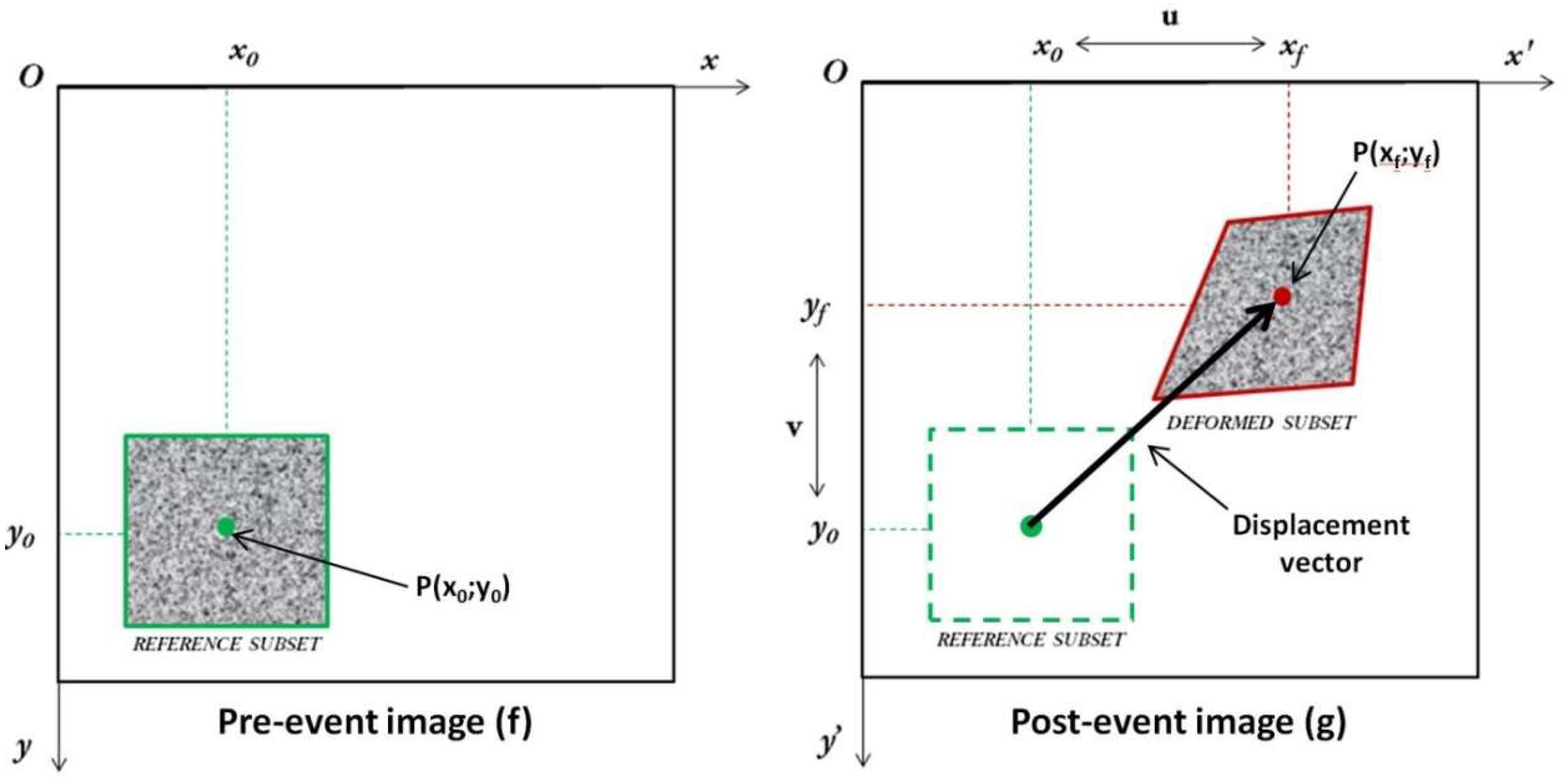

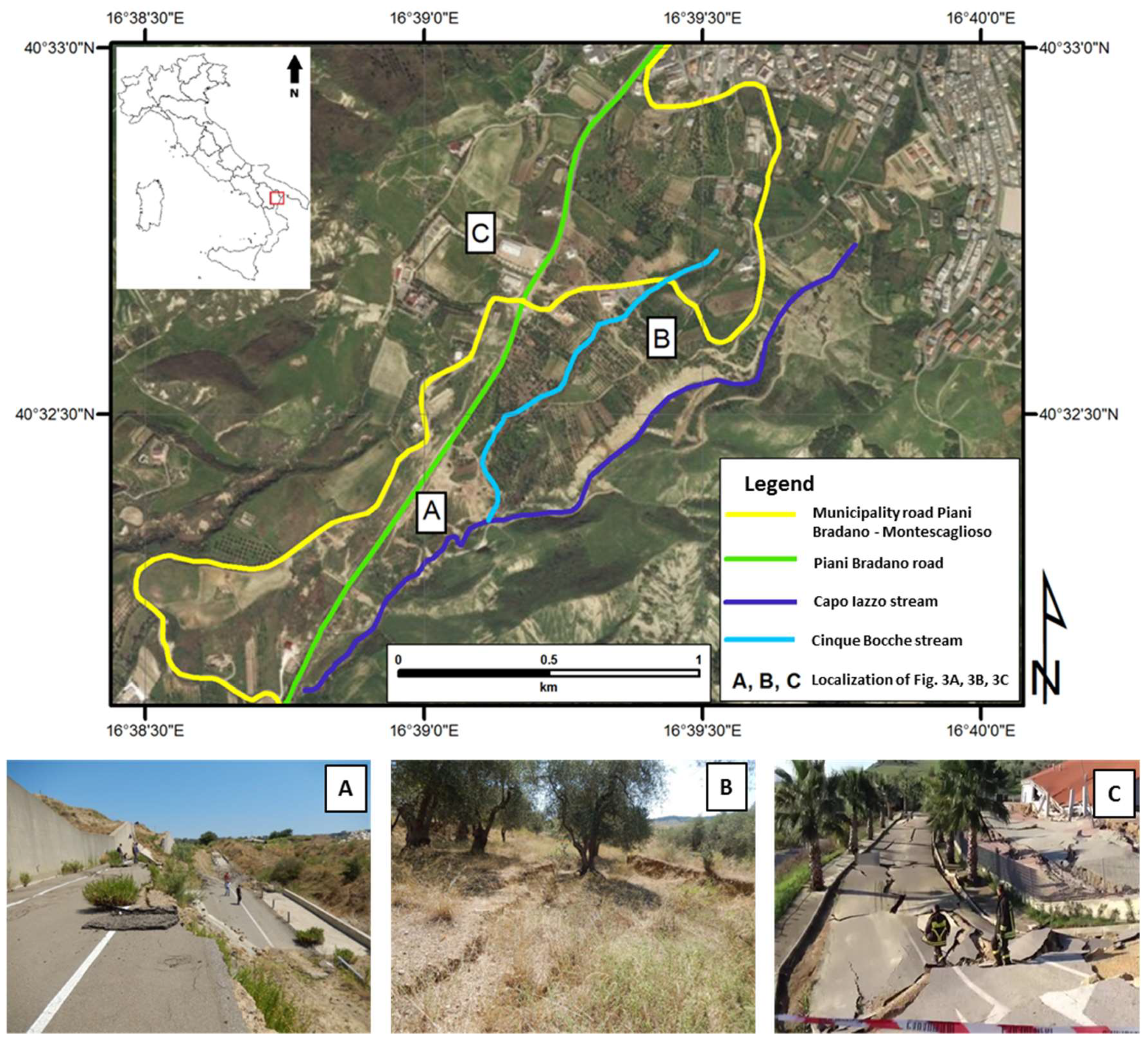
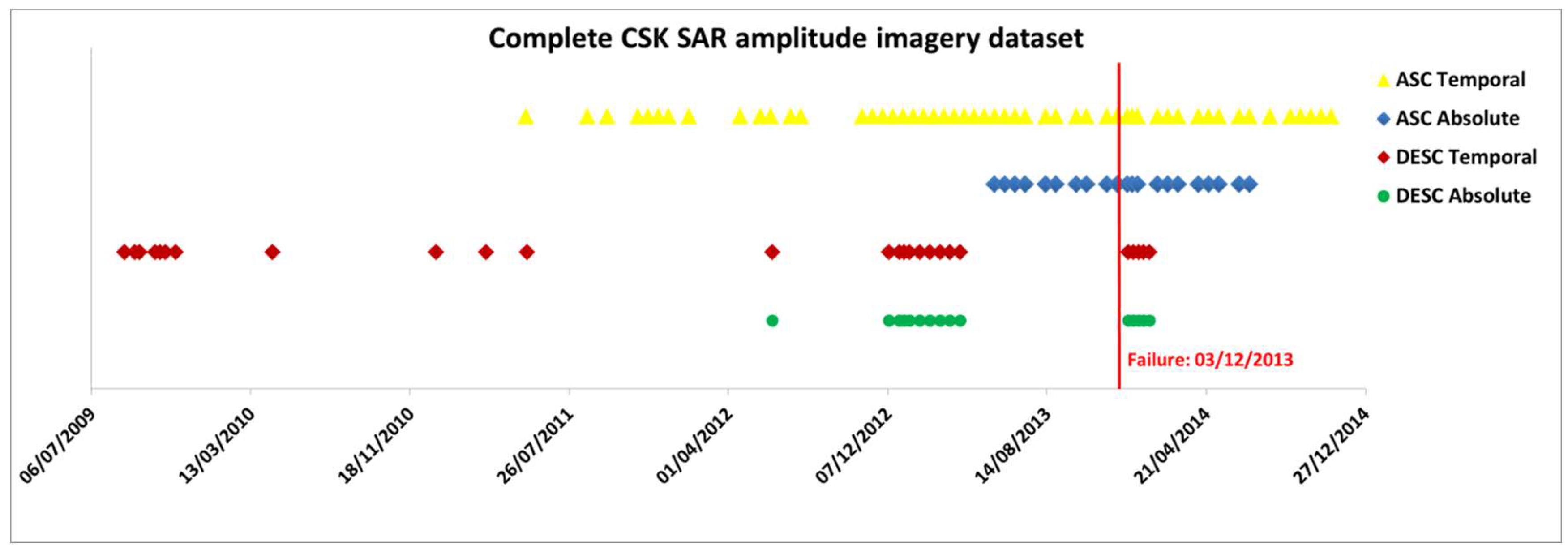
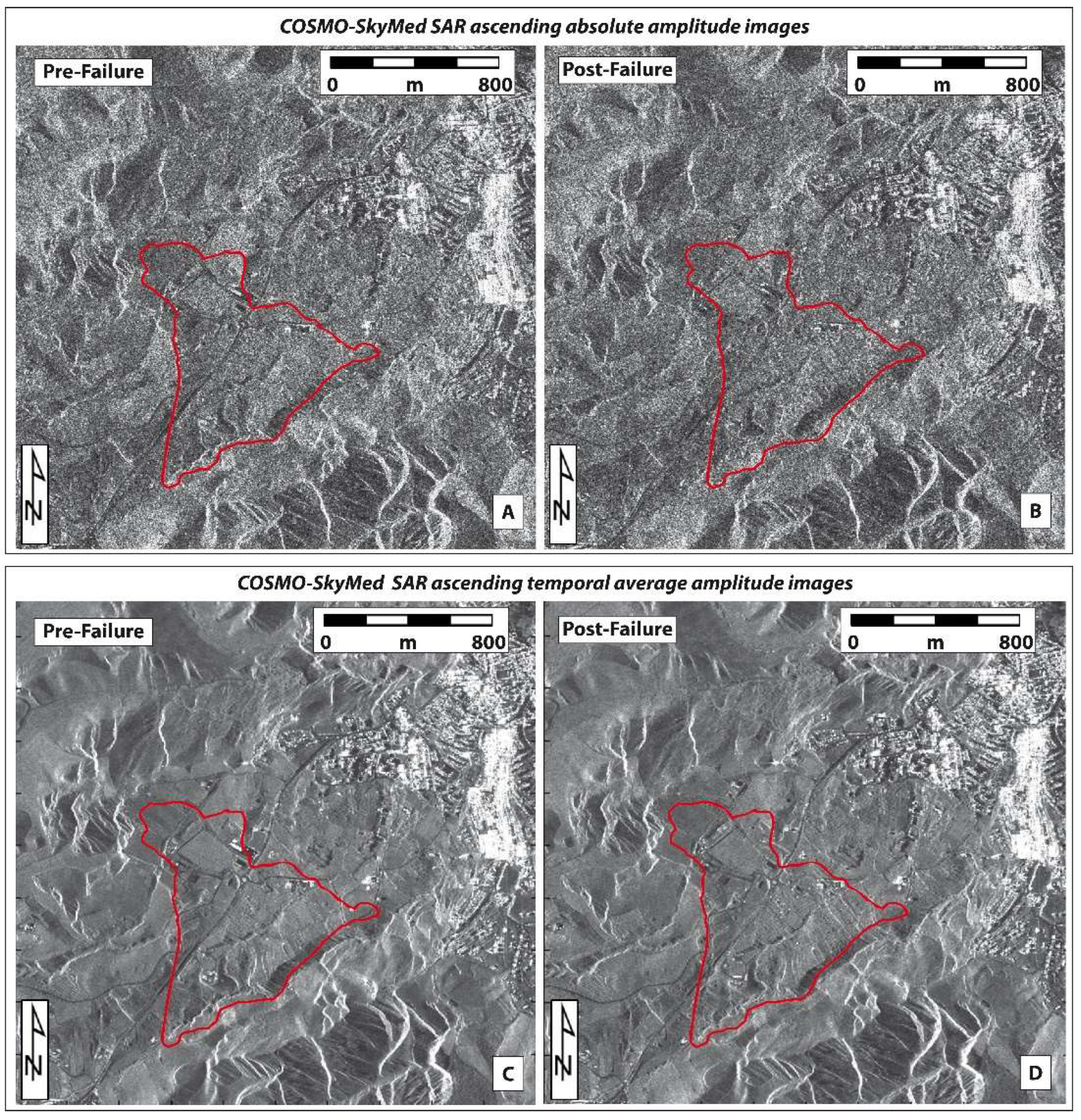
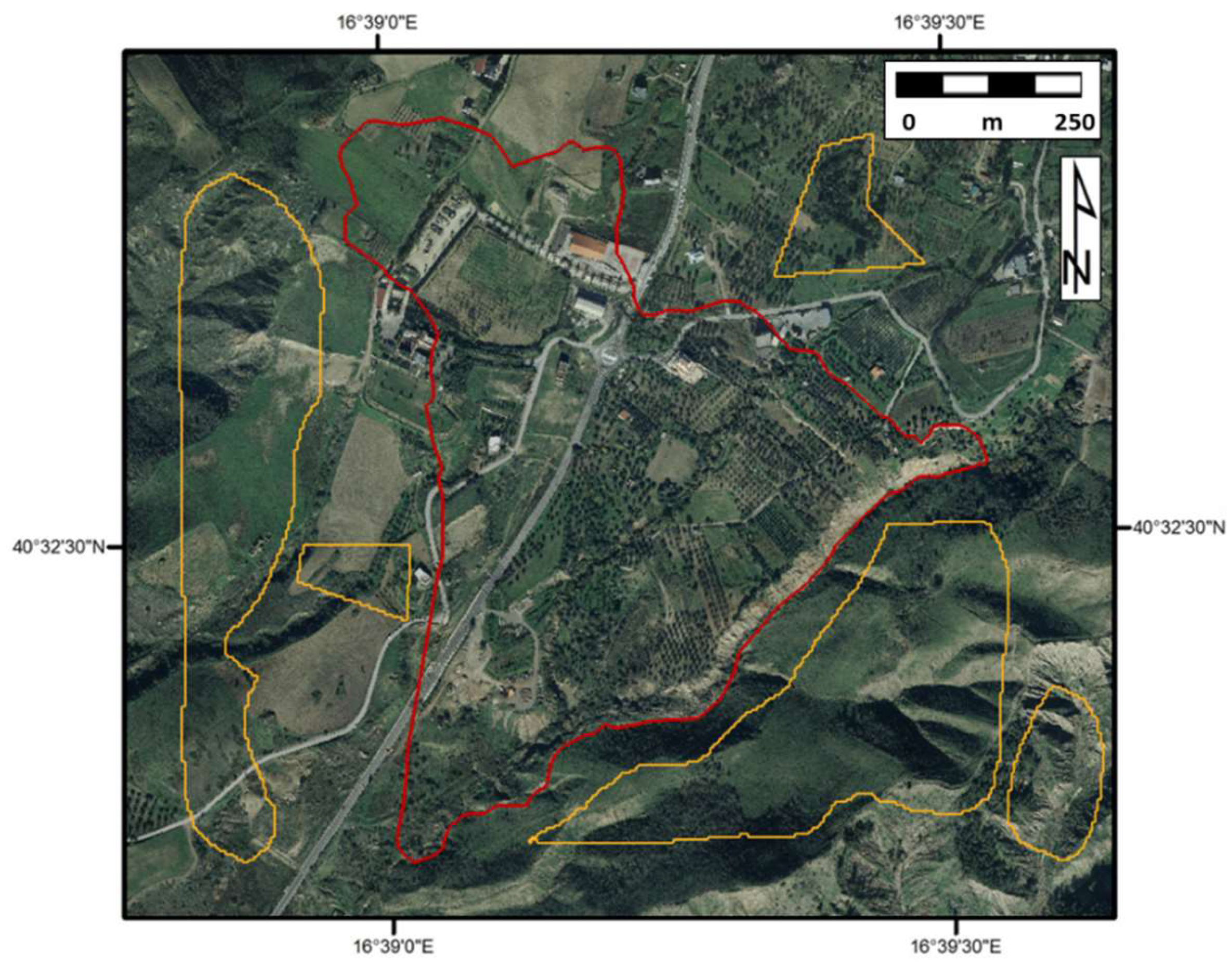
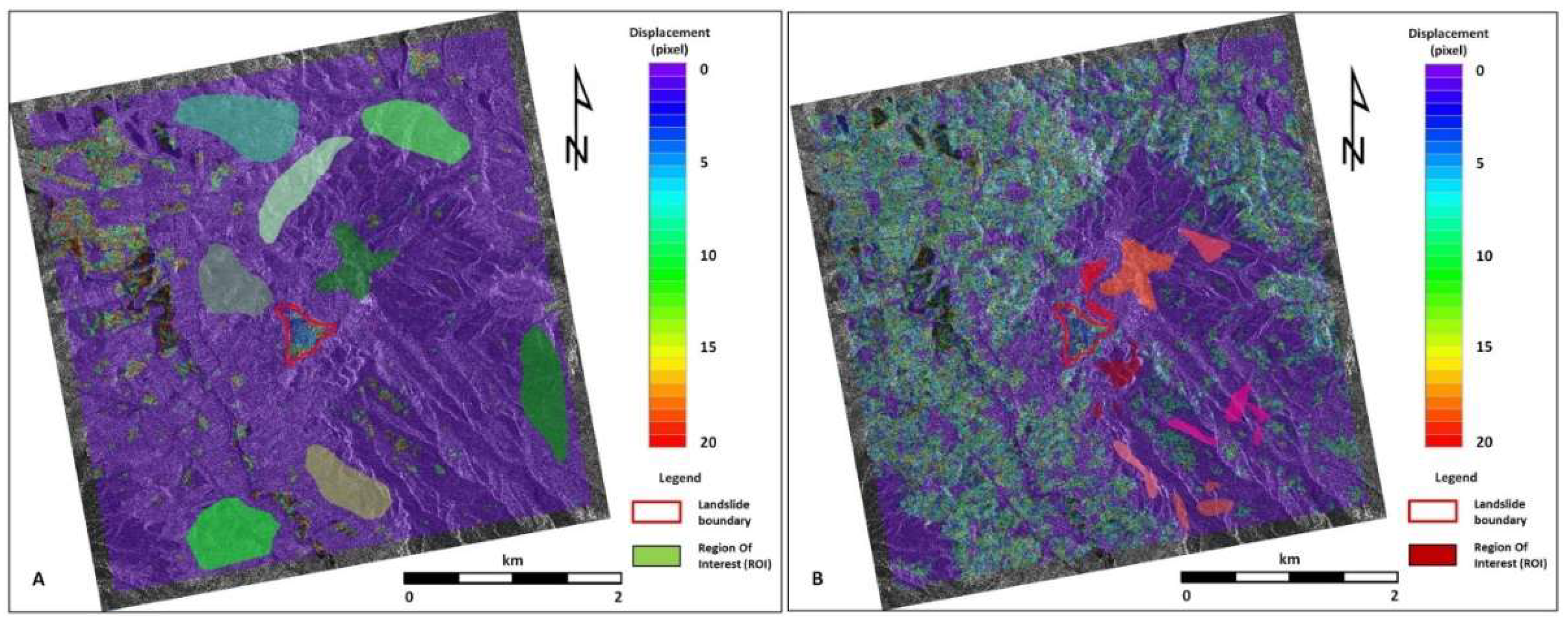
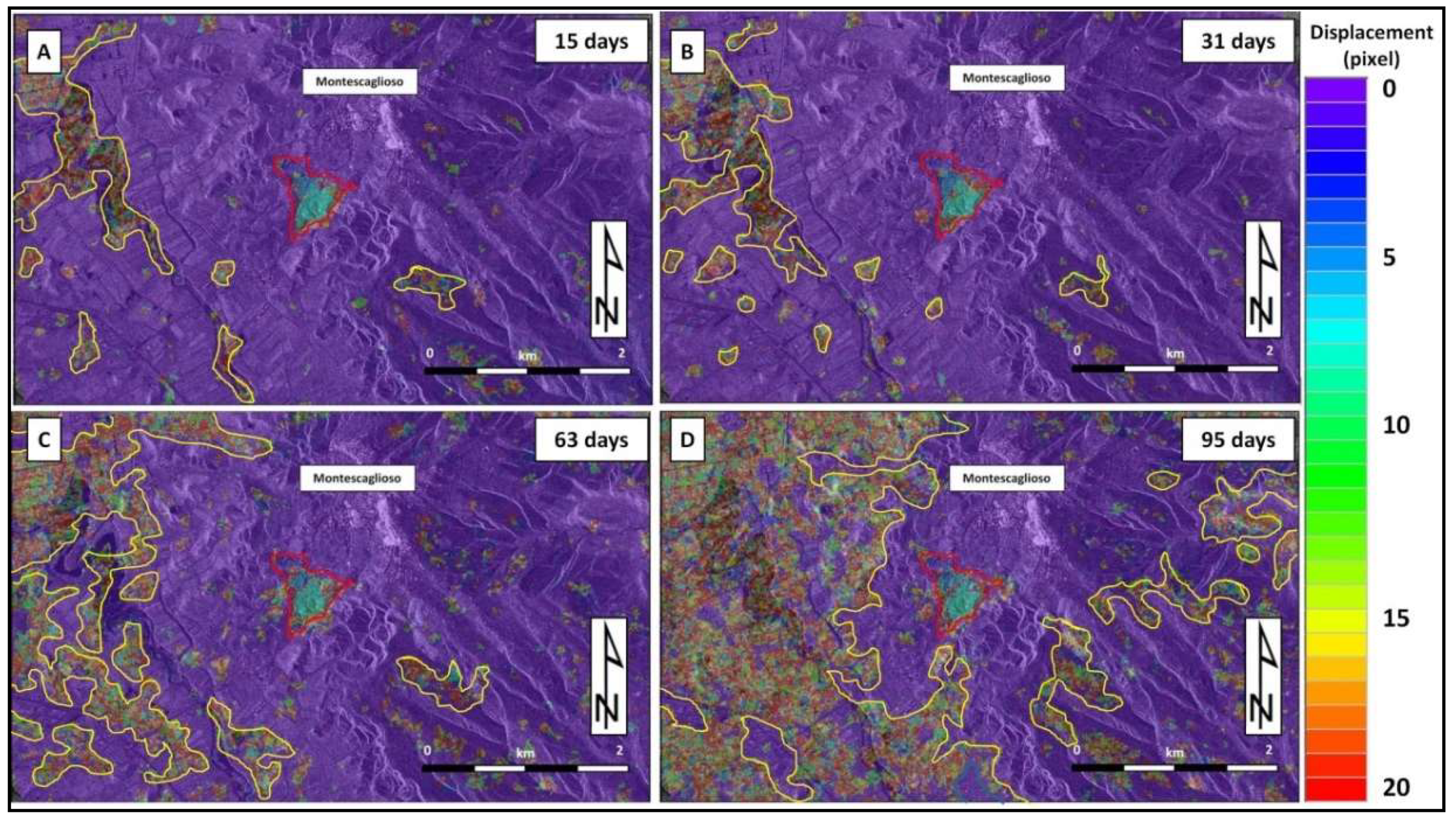

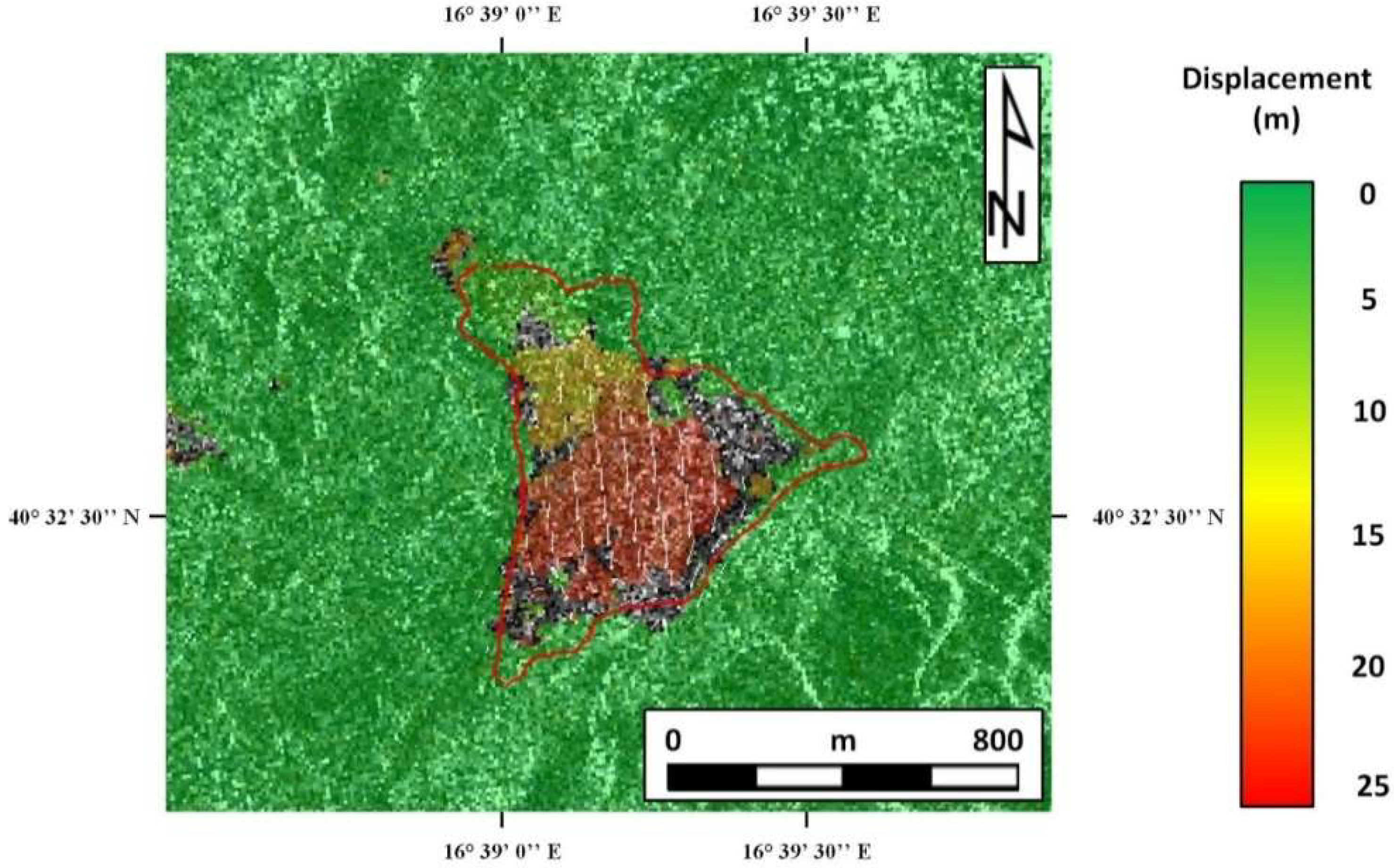
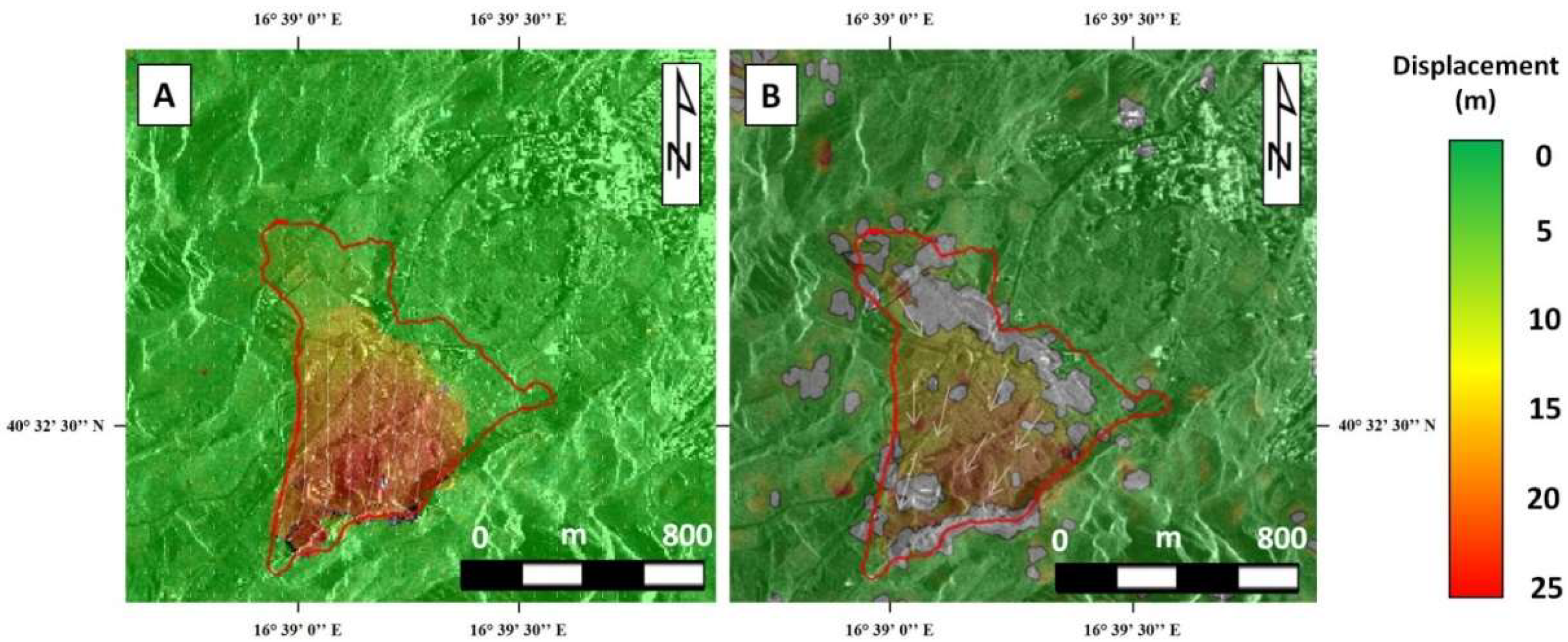
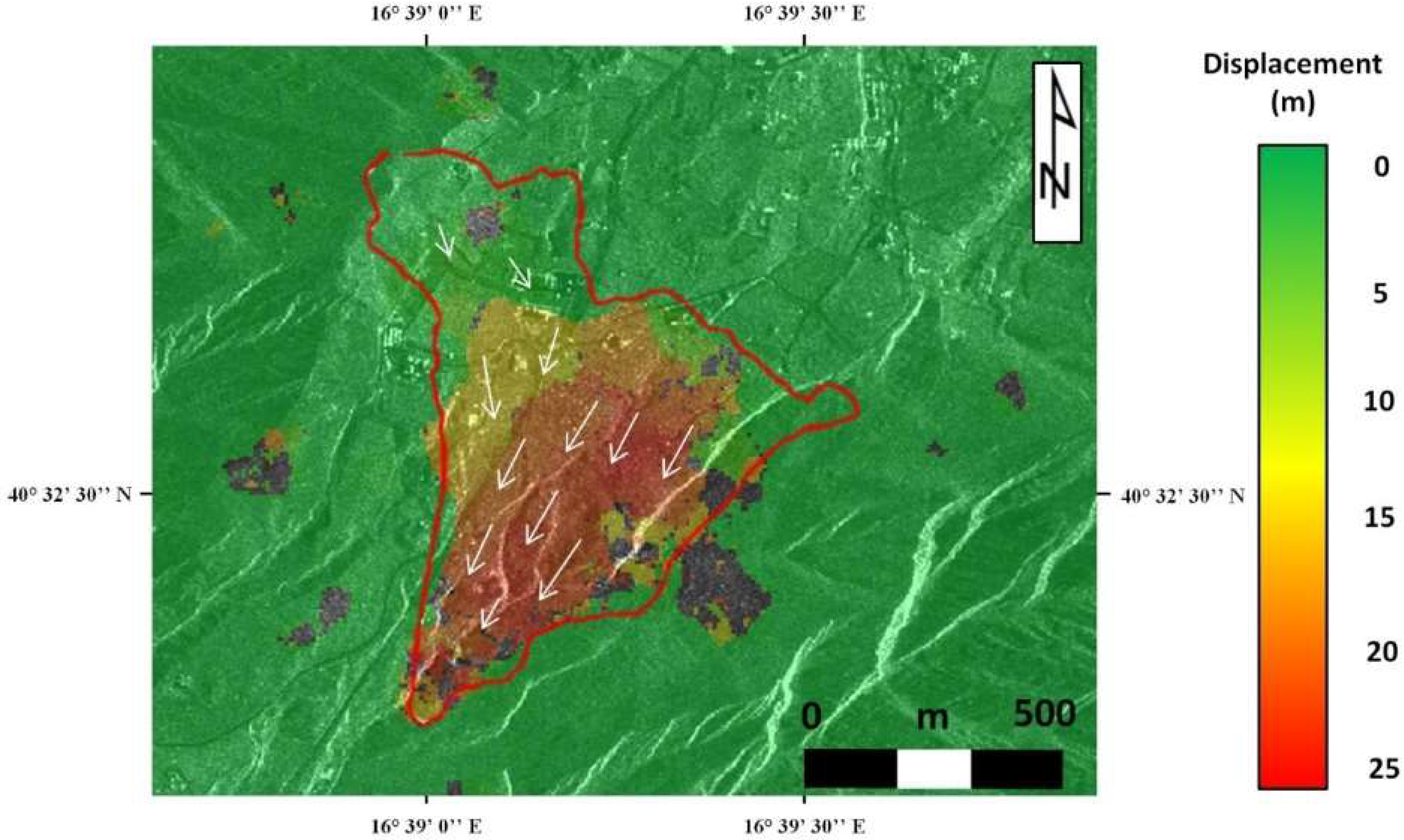
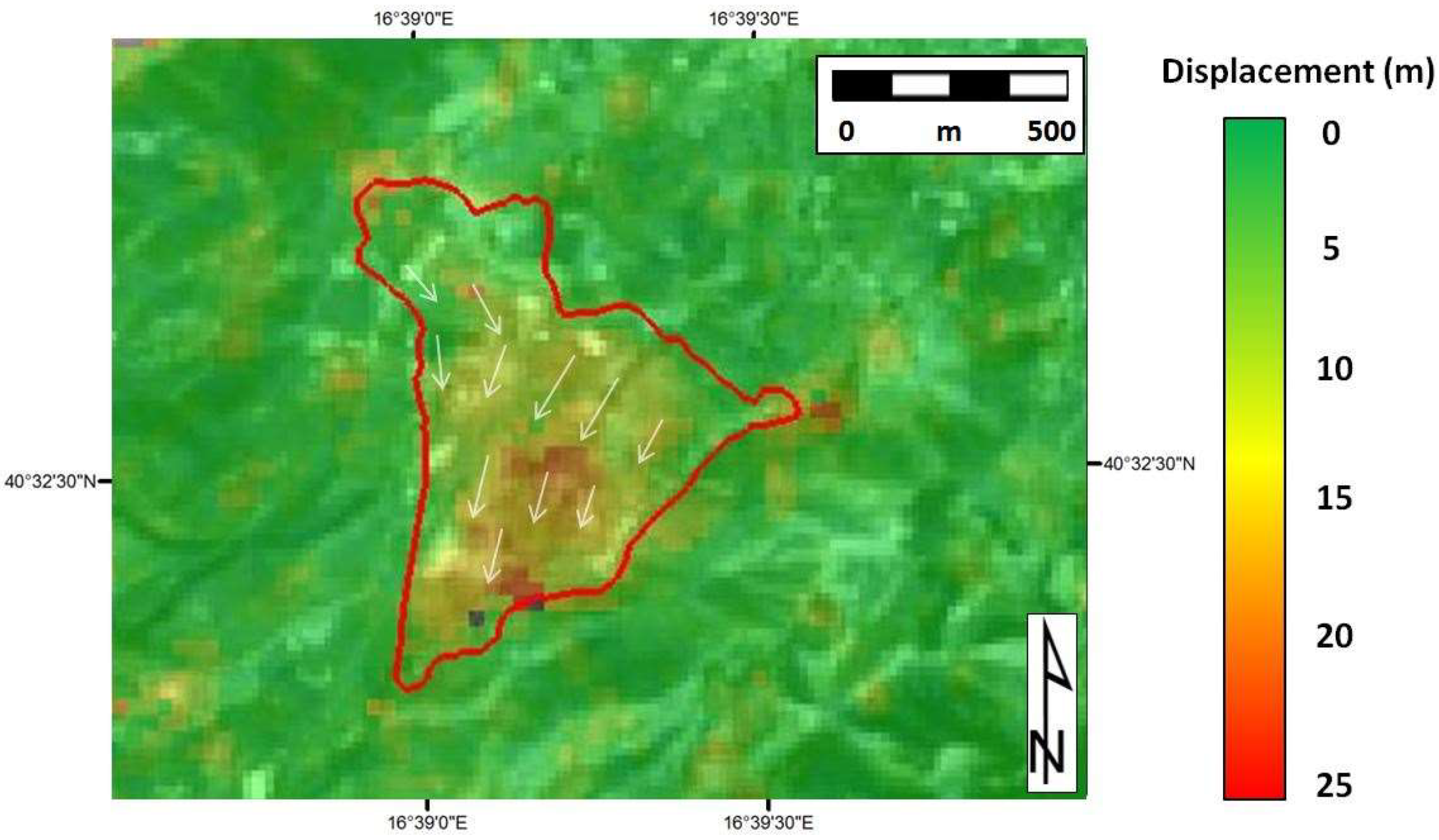
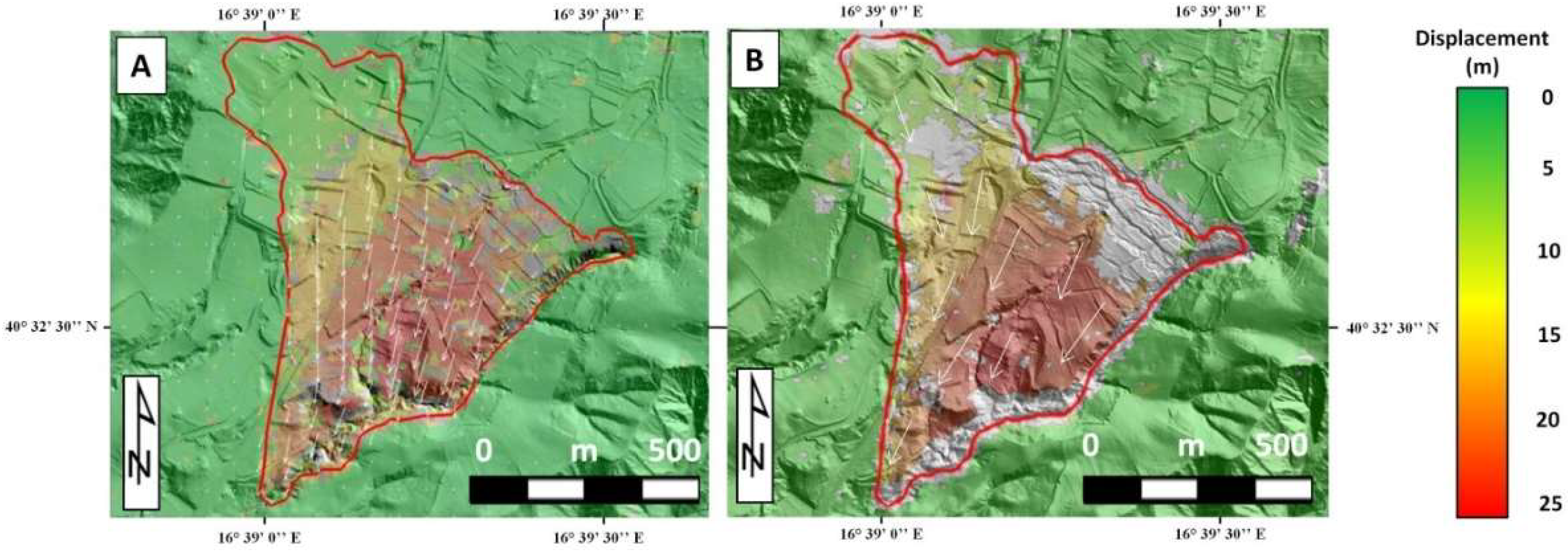
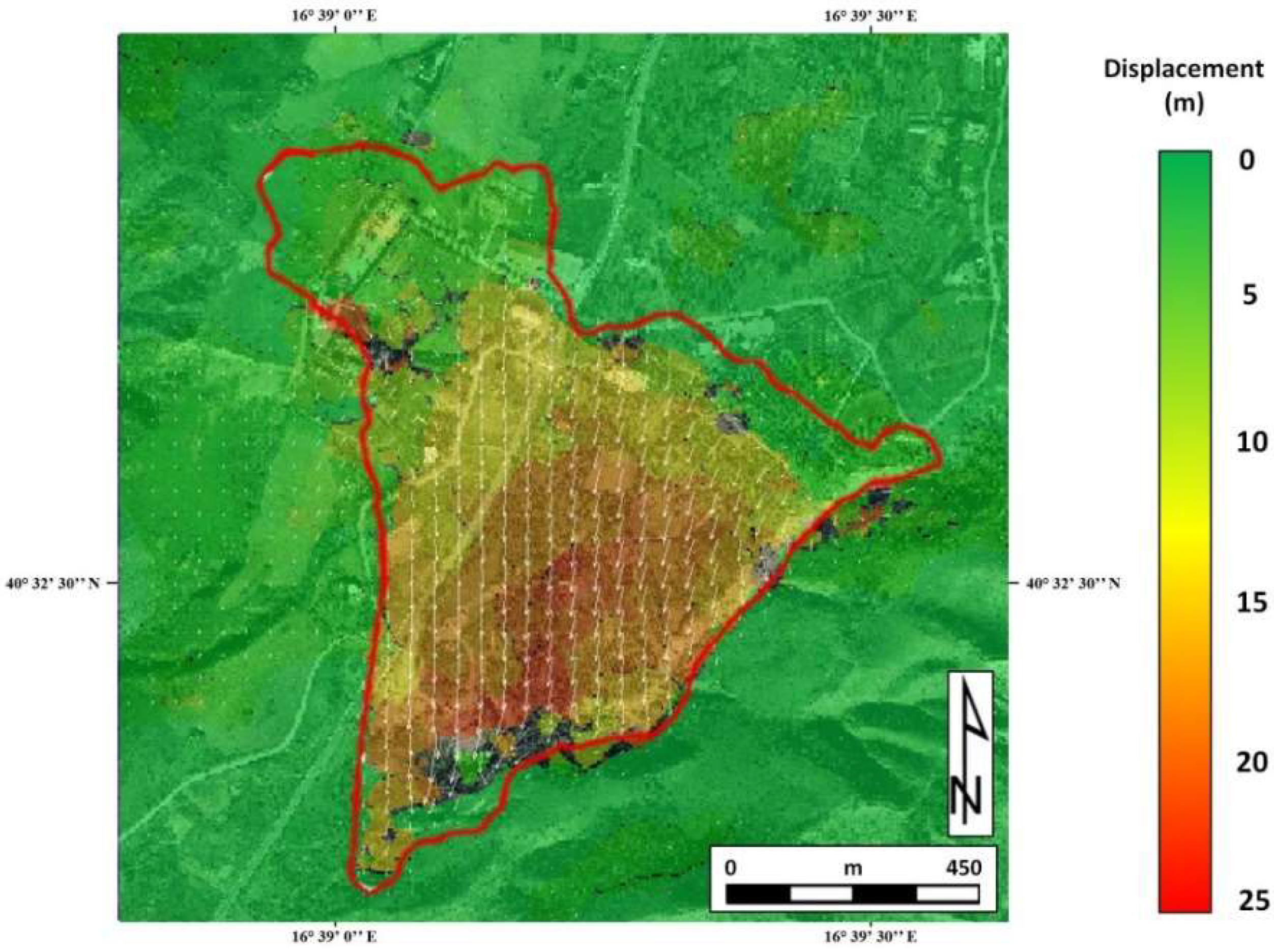
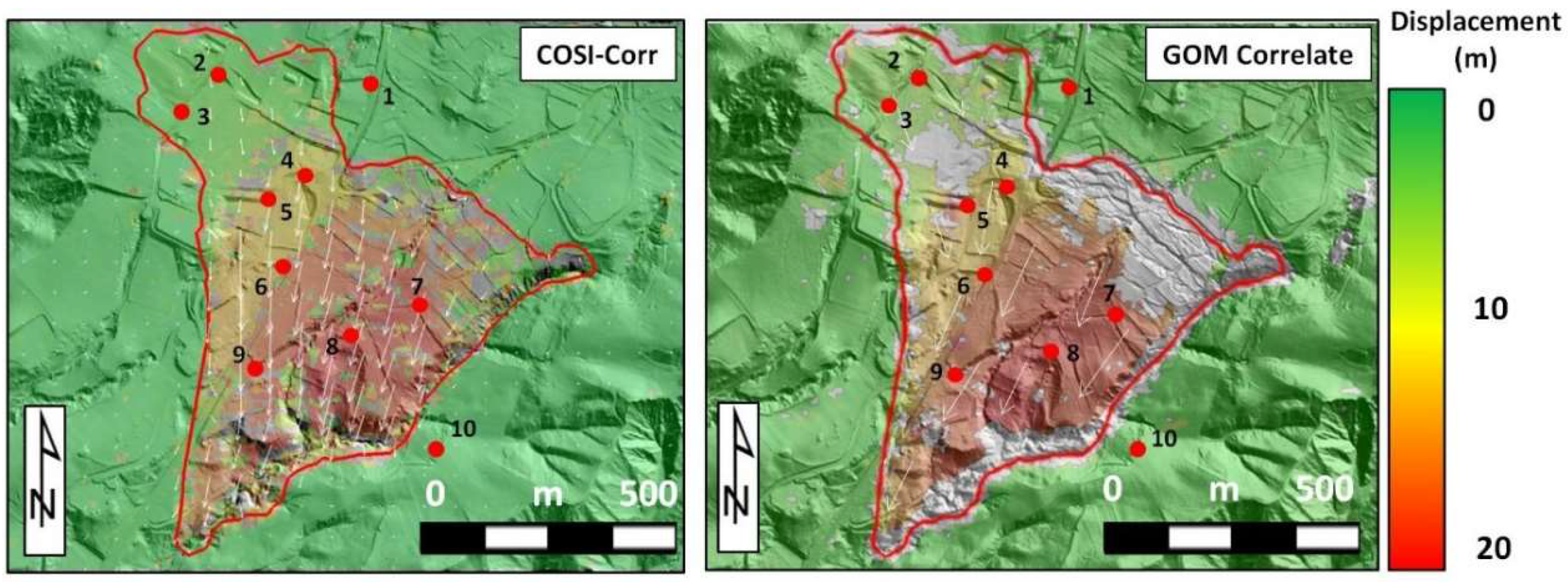

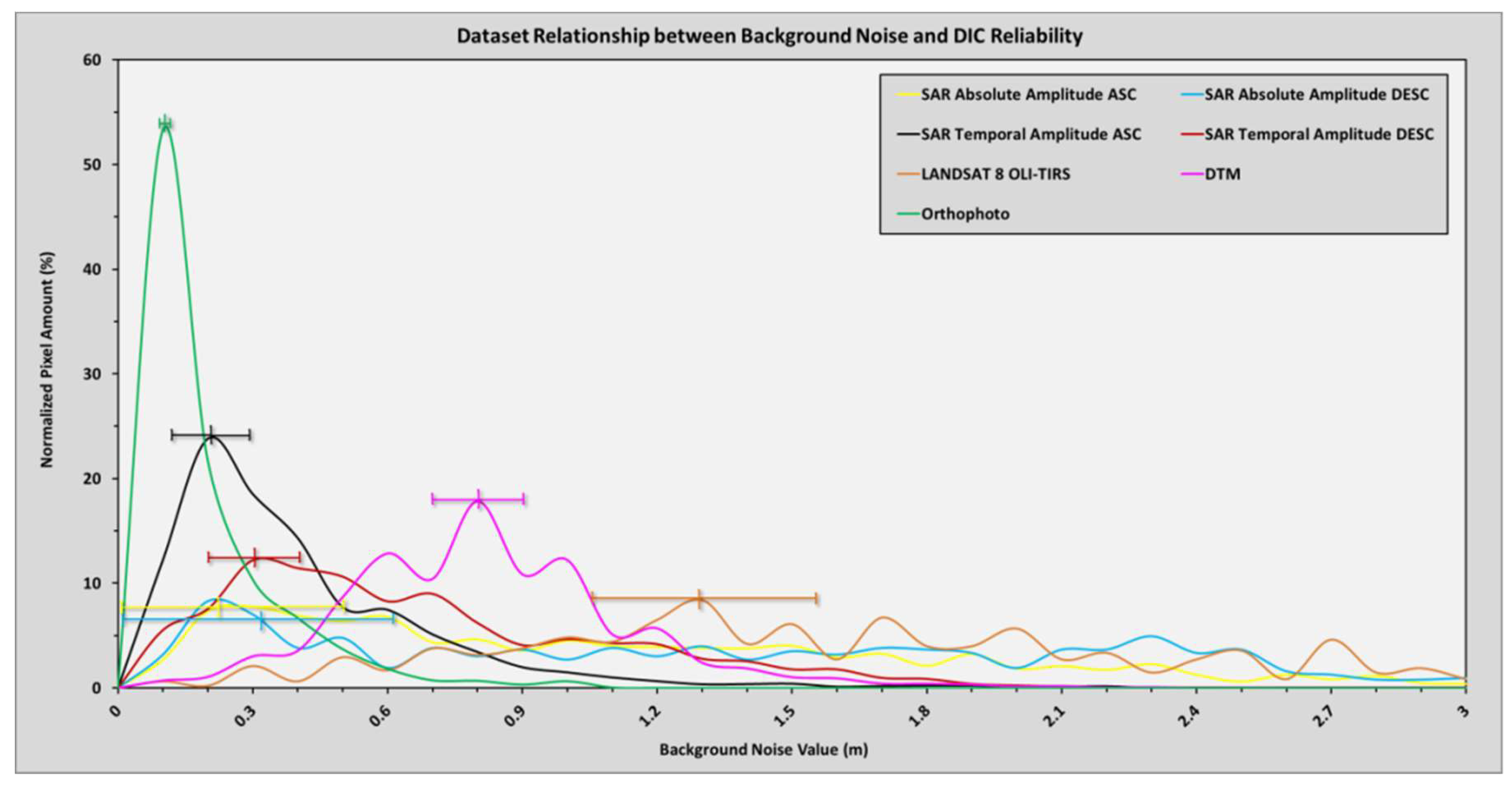
| Dataset | Platform | Sensor | Image | Geometrical Resolution (m/pixel) | Pre-Failure Image | Post-Failure Image |
|---|---|---|---|---|---|---|
| COSMO-SkyMed (CSK) ASC | Satellite | SAR | SAR absolute amplitude | 3 | 3 December 2013 | 18 December 2013 |
| COSMO-SkyMed (CSK) DESC | Satellite | SAR | SAR absolute amplitude | 3 | 31 March 2013 | 20 December 2013 |
| COSMO-SkyMed (CSK) ASC | Satellite | SAR | SAR temporal average amplitude | 3 | 19 May 2011–3 December 2013 | 18 December 2013–14 May 2015 |
| COSMO-SkyMed (CSK) DESC | Satellite | SAR | SAR temporal average amplitude | 3 | 27 August 2009–31 March 2013 | 20 December 2013–24 May 2015 |
| LANDSAT 8 OLI-TIRS | Satellite | Multi-spectral | Panchromatic | 15 | 26 October 2013 | 15 February 2014 |
| Digital Terrain Model (DTM) | Airborne | LiDAR | Shaded relief | 1 | July 2013 | December 2013 |
| Orthophoto | Airborne | Optical | High resolution | <1 | July 2013 | December 2013 |
| Dataset | Sensor | Image | Approach #1: Background Noise–Mean | Approach #2: Background Noise–Mean | Δ (Approach #1–Approach #2) |
|---|---|---|---|---|---|
| Pixel | Pixel | Pixel | |||
| COSMO-SkyMed (CSK) ASC | SAR | SAR absolute amplitude | ~0.14 | ~0.47 | 0.33 |
| COSMO-SkyMed (CSK) DESC | SAR | SAR absolute amplitude | ~0.12 | ~0.35 | 0.23 |
| COSMO-SkyMed (CSK) ASC | SAR | SAR temporal average amplitude | ~0.12 | ~0.10 | 0.02 |
| COSMO-SkyMed (CSK) DESC | SAR | SAR temporal average amplitude | ~0.15 | ~0.05 | 0.1 |
| LANDSAT 8 OLI-TIRS | Multi- spectral | Panchromatic | ~0.10 | ~0.05 | 0.05 |
| Digital Terrain Model (DTM) | LiDAR | Shaded relief | ~0.81 | ~0.80 | 0.01 |
| Orthophoto | Optical | Optical high-resolution | ~0.21 | ~0.20 | 0.01 |
| Master Image: 3 December 2013 | |||
|---|---|---|---|
| Post-Failure Images (Slaves) | Time Span from Master Image (gg) | Time Span from Master Image (years) | Pixels Affected by Decorrelated Signal (%) |
| 18 December 2013 | 15 | 0.04 | 32.0 |
| 23 December 2013 | 23 | 0.06 | 44.8 |
| 3 January 2014 | 31 | 0.08 | 30.2 |
| 4 February 2014 | 63 | 0.17 | 42.2 |
| 20 February 2014 | 79 | 0.22 | 41.1 |
| 8 March 2014 | 95 | 0.26 | 41.3 |
| 9 April 2014 | 147 | 0.40 | 43.6 |
| 25 April 2014 | 163 | 0.45 | 45.5 |
| 11 May 2014 | 179 | 0.49 | 45.9 |
| 12 June 2014 | 211 | 0.58 | 44.8 |
| 28 June 2014 | 227 | 0.62 | 46.6 |
| Dataset | COSI-Corr | GOM Correlate | |||||
|---|---|---|---|---|---|---|---|
| Frequency Correlator Engine | Surface Component | Pattern Quality Tool | Scale Calibration | ||||
| Window Size (pixels) | Step (pixels) | Window Size (pixels) | Point Distance (pixels) | Window Size (pixels) | Point Distance (pixels) | ||
| CSK SAR absolute ASC | 128 | 4 | 20 | 5 | 20 | 5 | Manually defined scale |
| CSK SAR absolute DESC | 256 | 8 | 50 | 5 | 50 | 5 | Manually defined scale |
| CSK SAR temporal average ASC | 64 | 2 | 20 | 5 | 20 | 5 | Manually defined scale |
| CSK SAR temporal average DESC | 128 | 4 | 50 | 5 | 50 | 5 | Manually defined scale |
| LANDSAT 8 OLI-TIRS | 16 | 2 | 50 | 5 | 50 | 5 | Manually defined scale |
| Shaded DTMs | 64 | 4 | 50 | 5 | 15 | 5 | Manually defined scale |
| HR Optical Orthophoto | 128 | 8 | 50 | 5 | 15 | 5 | Manually defined scale |
| ID | Displacement (pixel) | ||
|---|---|---|---|
| COSI-Corr | GOM Correlate | Δ (COSI-Corr vs. GOM Correlate) | |
| 1 | 0.88 | 0.75 | 0.13 |
| 2 | 3.35 | 3.16 | 0.19 |
| 3 | 3.21 | 3.09 | 0.12 |
| 4 | 11.89 | 11.35 | 0.54 |
| 5 | 12.61 | 12.68 | 0.07 |
| 6 | 16.07 | 16.26 | 0.19 |
| 7 | 18.34 | 18.53 | 0.18 |
| 8 | 18.89 | 19.07 | 0.18 |
| 9 | 16.39 | 16.23 | 0.16 |
| 10 | 0.73 | 0.62 | 0.11 |
| Dataset | COSI-Corr | GOM Correlate |
|---|---|---|
| CSK SAR absolute ASC | Yes | No |
| CSK SAR absolute DESC | Yes | No |
| CSK SAR temporal average ASC | Yes | Yes |
| CSK SAR temporal average DESC | Yes | Yes |
| LANDSAT 8 OLI-TIRS | Yes | No |
| Shaded DTMs | Yes | Yes |
| HR Optical Orthophoto | Yes | No |
© 2018 by the authors. Licensee MDPI, Basel, Switzerland. This article is an open access article distributed under the terms and conditions of the Creative Commons Attribution (CC BY) license (http://creativecommons.org/licenses/by/4.0/).
Share and Cite
Caporossi, P.; Mazzanti, P.; Bozzano, F. Digital Image Correlation (DIC) Analysis of the 3 December 2013 Montescaglioso Landslide (Basilicata, Southern Italy): Results from a Multi-Dataset Investigation. ISPRS Int. J. Geo-Inf. 2018, 7, 372. https://doi.org/10.3390/ijgi7090372
Caporossi P, Mazzanti P, Bozzano F. Digital Image Correlation (DIC) Analysis of the 3 December 2013 Montescaglioso Landslide (Basilicata, Southern Italy): Results from a Multi-Dataset Investigation. ISPRS International Journal of Geo-Information. 2018; 7(9):372. https://doi.org/10.3390/ijgi7090372
Chicago/Turabian StyleCaporossi, Paolo, Paolo Mazzanti, and Francesca Bozzano. 2018. "Digital Image Correlation (DIC) Analysis of the 3 December 2013 Montescaglioso Landslide (Basilicata, Southern Italy): Results from a Multi-Dataset Investigation" ISPRS International Journal of Geo-Information 7, no. 9: 372. https://doi.org/10.3390/ijgi7090372
APA StyleCaporossi, P., Mazzanti, P., & Bozzano, F. (2018). Digital Image Correlation (DIC) Analysis of the 3 December 2013 Montescaglioso Landslide (Basilicata, Southern Italy): Results from a Multi-Dataset Investigation. ISPRS International Journal of Geo-Information, 7(9), 372. https://doi.org/10.3390/ijgi7090372







